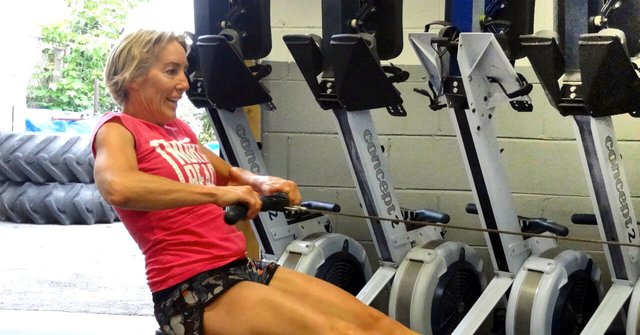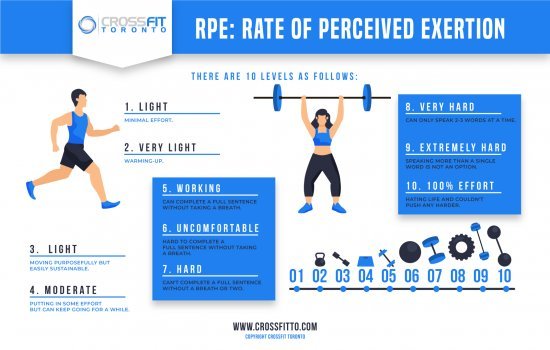
[et_pb_post_title featured_placement="background" text_background="on" _builder_version="3.22.7" title_font_size="72px" text_orientation="center"][/et_pb_post_title]
RPE (Rate/Rating of Perceived Exertion) is a self-assessed gauge of how hard you feel you're working.
The original RPE scale is known as the Borg Scale and ranges from 6 to 20.
For simplicity, however, most of us use a 1-10 scale (or maybe 0-10).
If a health care practitioner has ever asked you to rate your level of pain on a scale of 1 to 10, this is pretty much the same thing, except for effort.
Why should we care about RPE? What does it give us?
Great question. Glad you asked!
We primarily use RPE to help modulate our conditioning workouts.
When the clock is running we often push ourselves quite hard, sometimes too much so, especially if it's workout or set of movements we like.
But that's not always appropriate. In fact, pushing really hard on a frequent basis probably doesn't help us much. For most of us, any more than a couple of really tough workouts a week is likely doing more harm than good.
By modulating intensity throughout a training cycle using the RPE assessment, we are better able to balance our efforts with our recovery and therefore progress faster.
The Research
One 2013 study looked at a group of over 2,500 people to examine the relationship between RPE and physiological exercise parameters, namely heart rate and lactate concentration.
What they discovered was that subjective assessments appear to map closely to what heart rate and lactate levels show.
Another study in 2015 examined the relationship between prescribed and self-regulated high intensity interval training. Target heart rates and RPE effort levels were assigned to the study participants.
This study showed that there was no significant difference between the heart rate achieved by perceived effort and that achieved through direct measured feedback.
Granted this last study only involved 8 individuals, there appears to be a strong correlation between RPE and specific physiological exercise parameters.
In short, the science seems to show that the RPE scale is a valid way to "train by feel".
Gauging RPE
While the Borg Scale uses a scale of 6-20, we prefer the simpler 1-10 scale.
Here's how we break that down:
- Extremely Light
- Very Light
- Light
- Moderate
- Working
- Uncomfortable
- Hard
- Very Hard
- Extremely Hard
- 100% Effort
Using RPE
Let's take 1 week training cycle with 5 days of training as an example. Here's how we might modulate our efforts across the week.
- Monday: RPE 8
- Tuesday: RPE 6
- Wednesday: RPE 7
- Thursday: RPE 6
- Friday: RPE 9
This gives us a typical Medium-Light-Heavy pattern that is often used in strength training.
We could use the following for a similar effect.
- Monday: RPE 8
- Tuesday: RPE 7
- Wednesday: RPE 6
- Thursday: RPE 7
- Friday: RPE 9
If you prefer to open the week with a hard workout, this might be a good breakdown:
- Monday: RPE 9
- Tuesday: RPE 7
- Wednesday: RPE 8
- Thursday: RPE 6
- Friday: RPE 7
In the end, there's more than 1 way to spread out effort.
What is "right" depends on you: your needs, your preferred training style, and your current lifestyle and situation.
Remember that variety and balance are key.
Let us know if/how you use RPE in your training!
[et_pb_code admin_label="Starbox Author Box"][starbox][/et_pb_code][et_pb_code disabled_on="on|on|off" admin_label="Bloom Email Optin"][et_bloom_inline optin_id="optin_3"][/et_pb_code][et_pb_comments show_count="off" _builder_version="3.16" button_text_size__hover_enabled="off" button_one_text_size__hover_enabled="off" button_two_text_size__hover_enabled="off" button_text_color__hover_enabled="off" button_one_text_color__hover_enabled="off" button_two_text_color__hover_enabled="off" button_border_width__hover_enabled="off" button_one_border_width__hover_enabled="off" button_two_border_width__hover_enabled="off" button_border_color__hover_enabled="off" button_one_border_color__hover_enabled="off" button_two_border_color__hover_enabled="off" button_border_radius__hover_enabled="off" button_one_border_radius__hover_enabled="off" button_two_border_radius__hover_enabled="off" button_letter_spacing__hover_enabled="off" button_one_letter_spacing__hover_enabled="off" button_two_letter_spacing__hover_enabled="off" button_bg_color__hover_enabled="off" button_one_bg_color__hover_enabled="off" button_two_bg_color__hover_enabled="off"][/et_pb_comments][et_pb_sidebar area="sidebar-1" _builder_version="3.0.74"][/et_pb_sidebar]Posted from my blog with SteemPress : https://www.crossfitto.com/rate-of-perceived-exertion-rpe-what-why-how/

Congratulations @veeev! You have completed the following achievement on the Steem blockchain and have been rewarded with new badge(s) :
You can view your badges on your Steem Board and compare to others on the Steem Ranking
If you no longer want to receive notifications, reply to this comment with the word
STOPTo support your work, I also upvoted your post!
Do not miss the last post from @steemitboard:
Vote for @Steemitboard as a witness to get one more award and increased upvotes!
Downvoting a post can decrease pending rewards and make it less visible. Common reasons:
Submit
Congratulations @veeev! You received a personal award!
You can view your badges on your Steem Board and compare to others on the Steem Ranking
Vote for @Steemitboard as a witness to get one more award and increased upvotes!
Downvoting a post can decrease pending rewards and make it less visible. Common reasons:
Submit